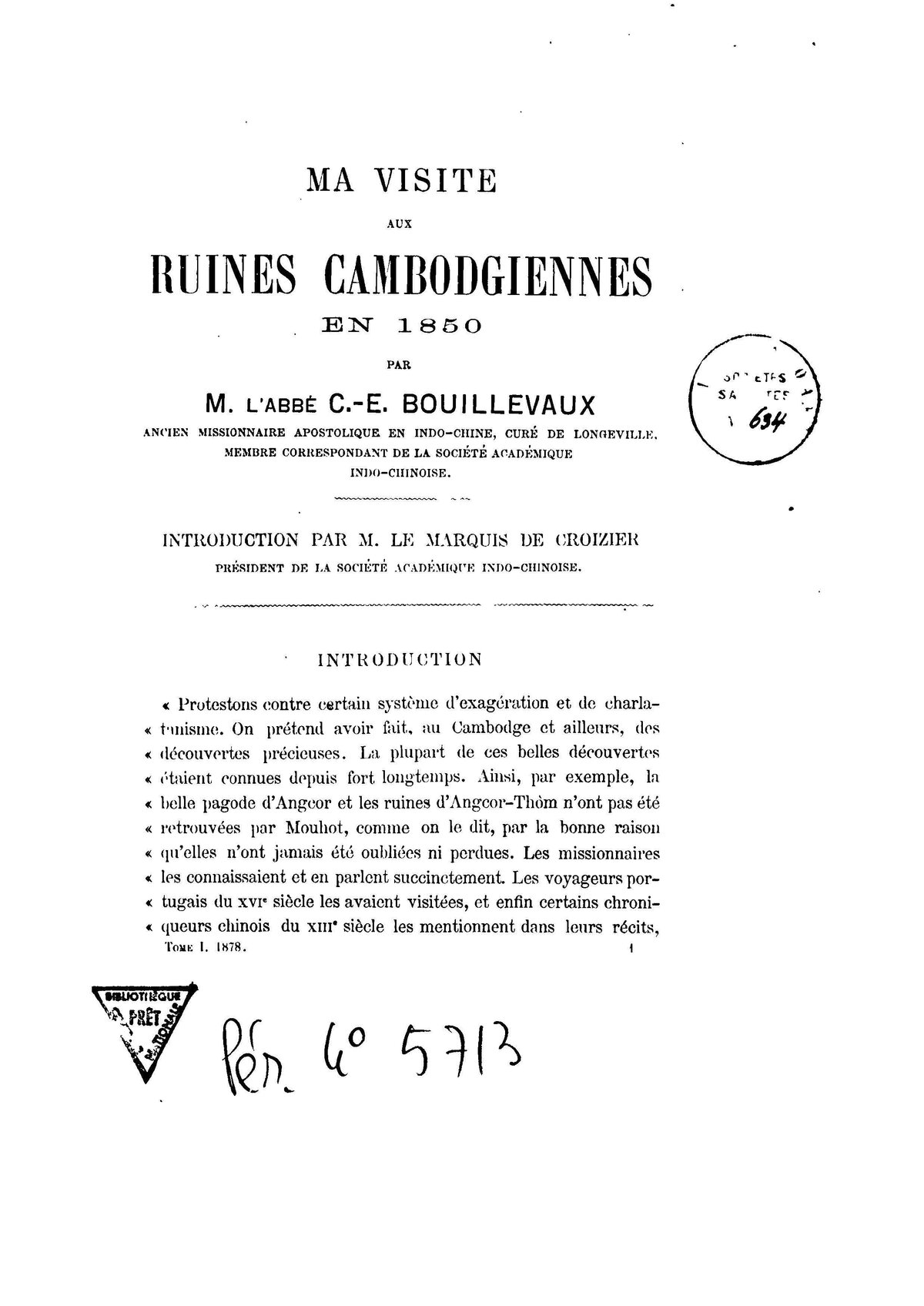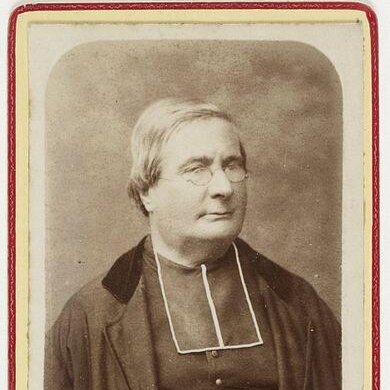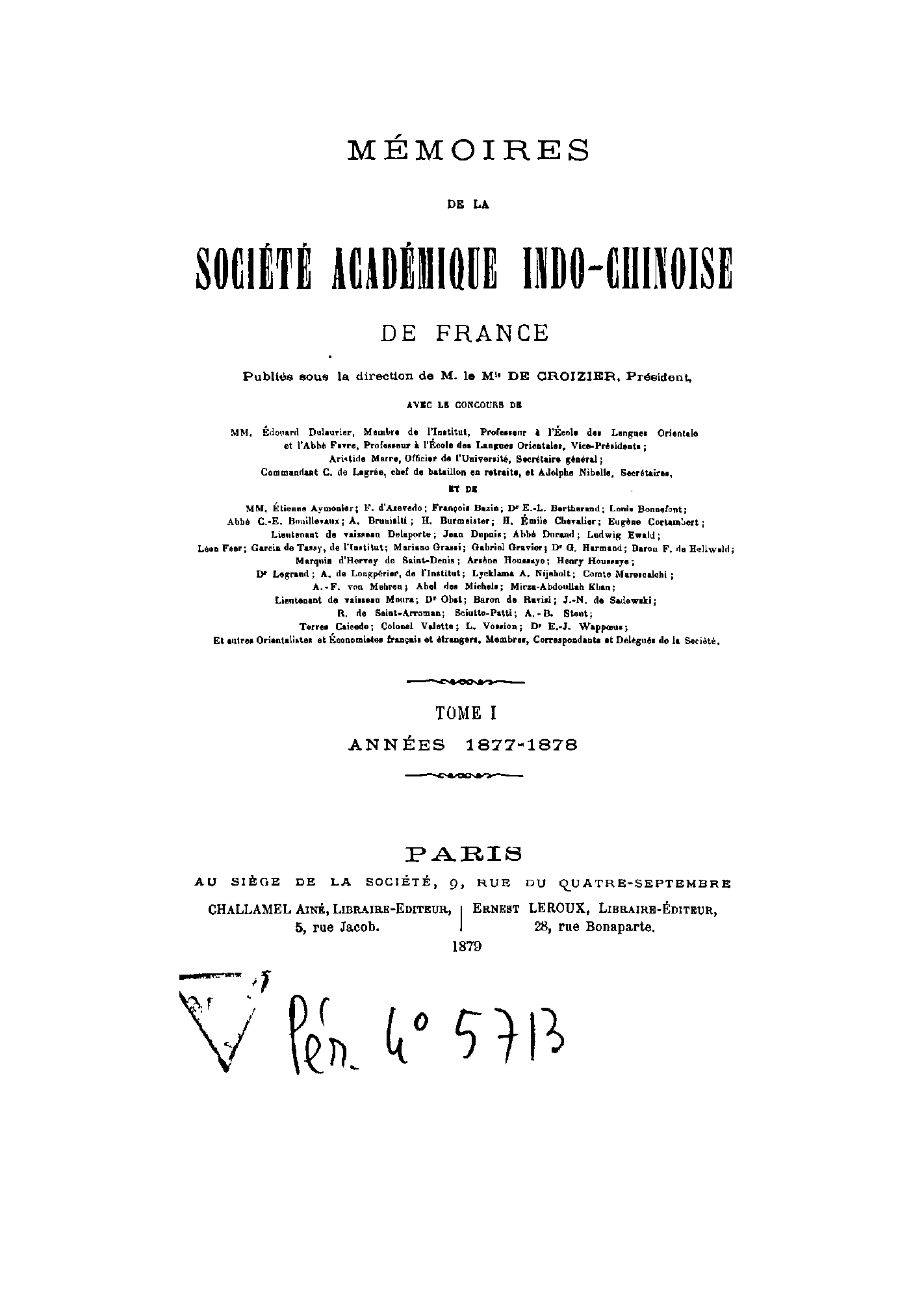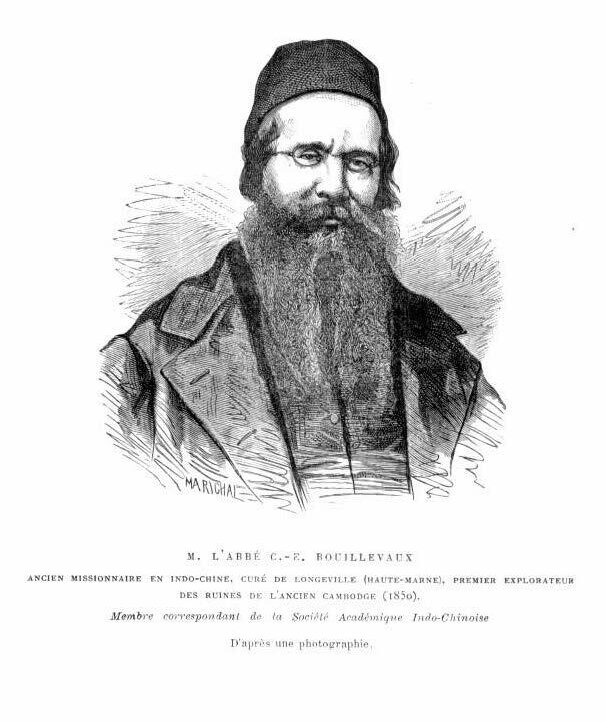Ma visite aux ruines cambodgiennes en 1850 | 'My visit to the ruins of Cambodia in 1850'
by C.-E. Bouillevaux
Realizing he had overlooked the significance of Angkor in his previous travelogues, the resourceful and pugnacious abbot came back with a vengeance later.

Publication: Mémoires de la Société académique de l'Indo-Chine, t I, E. Leroux, Paris, p 2-21 | ADB Digital Document
Published: 1877
Author: C.-E. Bouillevaux
Pages: 19
Language : French
pdf 734.3 KB
Published as the first contribution to the first (and only) volume of the review launched by De Croizier (with the reluctant support of Louis Delaporte and Etienne Aymonier), this is basically a pamphlet against Henri Mouhot: “Protestons contre certain systeme d’exagération et de charlatanisme. On prétend avoir fait au Cambodge et ailleurs des découvertes précieuses. La plupart de ces belles découverte étaient connues ùrpuis fort. longtemps. Ainsi par exemple, la belle pagode d’Angcor et les ruines d’Angcor-Thôm n’ont pas été retrouvées par Mouhot, comme on le dit, par la bonne raison qu’elles n’ont jamais été oubliées ni perdues. Les missionnaires les connaissaient et en parlent succinctement. Les voyageurs portugais du XVIeme siècle les avaient visitées, et enfin certains chroniqueurs chinois du XIIIeme siècle les mentionnent dans leurs récits, d’une façon plus ou moins claire. Mouhot a vu Angcor après plusieurs autres, et en particulier après moi. Son voyage ayant eu une grande publicité, il a fait connaître ce pays à beaucoup de lecteurs. MM. les officiers de l’expédition du Mékhong, M. de La Grée surtout, ont étudié ces monuments d’une manière spéciale, et en ont donné des descriptions intéressantes. Cela est vrai…Mais n’exagérons rien!” [“Let us censure certain systemic exaggeration and charlatanism. Precious discoveries are claimed to have been made in Cambodia and elsewhere. Most of these admirable discoveries were known for a very long time. Thus, for example, the beautiful pagoda of Angcor and the Ruins of Angcor-Thôm were not found by Mouhot, as they say, for the good reason that they were never forgotten or lost. The missionaries knew them and speak of them succinctly.Portuguese travelers of the 16th century century had visited them, and finally some Chinese chroniclers of the 13th century mention them in their accounts, more or less clearly. Mouhot saw Angcor after several others, and in particular after me. His trip having had great publicity , he made this country known to many readers. The officers of the Mekhong expedition, especially M. de La Grée, have studied these monuments in a special way, and have given interesting descriptions of them. This is true…but let’s not exaggerate!”
The tone is set from the first lines, and in his preamble de Croizier leaps to the poor indignant abbot’s rescue by claiming practically all authors, and especially Francis Garnier, have shamelessly plagiarized or lifted entire parts from de Bouillevaux’s work. And the abbot himself, although calming down at the end of his essay, attempts to claim the paternity of the “rediscovery of Angkor”: “Je fis imprimer, en 1857, chez Mme veuve Laguerre, à Bar-le-Duc, un petit ouvrage intitulé: Voyage dans l’Indo-Chine. Henri Mouhot, dans son voyage au Cambodge et aux ruines khmêrs, avait dans ses bagages un exemplaire de mon ouvrage. Cet intrépide voyageur était un homme de mérite, qui est mort victime de son amour pour la science : c’est très-vrai. Qu’on le loue, qu’on honore sa mémoire : c’est très-bien. Mais il n’a pas découvert Angcor. Les missionnaires connaissaient les ruines khmêrs, et j’ai visité et décrit brièvement ces antiques monuments, plusieurs années avant Mouhot...” [“I had printed, in 1857, at Madame Veuve Laguerre, in Bar-le-Duc, a small work entitled: Voyage dans l’Indo-Chine. Henri Mouhot, in his journey to Cambodia and the Khmer ruins, had in his luggage a copy of my work. This intrepid traveler was a man of merit, who died the victim of his love for science: it is very true. Let us praise him, let us honor his memory: all that is very well. But he did not discover Angcor. The missionaries knew the Khmer ruins, and I visited and briefly described these ancient monuments, several years before Mouhot…”
While his description of Angkor proper is more succint than the account of his navigation on the “Great Lake’ (Tonle Sap Lake), the author stresses again and again the contribution of Christian missionaries, even when he slightly mocks their level of literacy: “Nous savons que des missionnaires, des voyageurs, des marchands portugais et hollandais séjournèrent au Cambodge: visitèrent-ils les monuments Khmêrs? Voici ce qu’écrivait, en février 1783, M. Pierre Langenois, qui évangélisa pendant longtemps l’illustre royaume de Kamphoxa. Nous le citons avec son style plus ou moins correct: “Le Cambodge a des signes qu’ii était jadis presque tout submergé, selon l’histoire chinoise, laquelle raconte que les tours de Banon à Battâmhâng et la forteresse de pierres à Angcor, si renommée dans ces parties-cy, et qui est la principale province du Cambodge, a été faite par les Malabares, environ vingt ans avant la naissance de Jésus-Christ, quand la mer était à côté, dont le grand lac est encore un reste: quand. l’empereur de Chine envoya chercher le saint du côté de l’Occident, etc. ” Quoi qu’il en soit de l’érudition du père Langenois, créole de Maurice qui né savait pas très-bien le français et n’avait, sans doute, pas fait de grandes études littéraires, au moins est-il certain qu’il connaissait la pagode d’Angcor, la forteresse de pierres, comme il l’appelle.”[“We know that missionaries, travelers, Portuguese and Dutch merchants stayed in Cambodia: did they visit the Khmer monuments? Here is what Mr. Pierre Langenois wrote in February 1783, he who evangelized the illustrious kingdom for a long time. We quote him with his more or less correct style: “Cambodia has signs that it was once almost completely submerged, according to Chinese history, which tells that the towers of Banon at Battâmhâng and the stone fortress at Angcor, so renowned in these parts-cy, and which is the principal province of Cambodia, was made by the Malabars, about twenty years before the birth of Jesus Christ, when the sea was beside it, of which the great lake is still a remainder: when. the emperor of China sent for the saint from the side of the West, etc. “Whatever the erudition of Father Langenois, a Creole from Mauritius who did not know French very well and had, no doubt, not made advanced literary studies, at least it is certain that he knew the pagoda of Angcor, the stone fortress, as he calls it.”]
Tags: French explorers, French travelers, 19th century, Tonle Sap Lake
About the Author

C.-E. Bouillevaux
Père Charles-Émile Bouillevaux (1 Apr. 1823, Montier-en-Der, France — 6 Jan. 1913, Montier-en-Der) was a French missionary and explorer who visited Angkor in December 1850 but waited until 1878 to publish an extensive account of his visit, Ma visite aux ruines cambodgiennes en 1850 (Mémoires de la Société académique indochinoise, T. 1), long after the popular interest encountered by Henri Mouhot’s description.
Reaching Cochinchina in 1849, he saw Angkor in 1850 and, a few months later, stayed with the Pnong (Penongs in the French transliteration) people in Northeastern Cambodia, traveled from Sambor to Ha-Tien in nine days, then stayed in Laos from 1853 to 1855, came back briefly to Cambodia in 1855 (Battambang). Following a brief return to Europe, he served as abbot of Choquan from 1867 to 1873. He was with the Société des Missions étrangeres, a French apostolic organization which had started to send missions to the Far East as early as 1661 (to Siam) and 1664 (to Cochinchina).
Contributing several articles to the periodical Courrier de Saigon, Bouillevaux published a Map of Cambodia, two relations of his travels in ‘Indochina’ (Voyages dans l’Indochine, 1848 – 1856 (Paris, Victor Palmé, 1858) and L’Annam et le Cambodge, Voyages et notices historiques (Paris, Victor Palmé, 1874).
Many historians of Angkor, including B.P. Groslier, have argued that Pere Bouillevaux did not immediately realize the significance of Angkor, even if he visited the Khmer ruins ten years before Henri Mouhot or John Thomson. George Coedès, however, granted him the privilege to be the first Western visitor of Angkor in the 19th century. As for Casimir-Edmee de Croizier, he wrote quite peremptorily in his 1878 brochure Les explorateurs du Cambodge: “La priorité pour l’exploration des monuments de l’ancien Cambodge lui appartient donc d’une façon incontestable, et son nom doit primer celui de tous les autres voyageurs.” [“The priority in the exploration of the monuments of ancient Cambodia irrefutably belongs to him, and his name must take precedence over that of all other travelers.”
This portrait completed Bouillevaux’s paper ‘Ma visite aux ruines cambodgiennes en 1850’ [‘My visit to the Ruins of Cambodia in 1850’] in Mémoires de la Société académique de l’Indochine, t. I, 1877. The caption in French reads: “Abbot C.E. Bouillevaux, former missionary in Indochina, abbot of Longueville (Haute-Marne), first explorer of the ruines of Ancient Cambodia (1850).”


